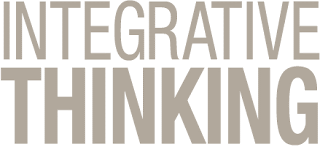For a last few months I have been baffled with the idea of a integrative thinking before I realized that "hey there are entire theories written on it" (nothing new under the sun). What is integrative thinking? Before I get into it, let me give you insights with what my observations have been so far in management thinking process. Growing up in the east with a western form of education, my primary management shaping & education was about moving from point A to C in a logical progression. If it was moving people from less desired state A to desired state C, you create chaos isolate the wrongs and move in linear fashion towards C. However in the eastern context where I lived the thinking was primarily circular in nature. Where the idea of getting to C may not be a exact linear process but may also have relational and time components that are not always strictly adhered to. Then there is the Jewish paradoxical way of thinking where except for the absolute truth all other ideas are held in the perfect tension of diametrically opposite ideas. They rest in the middle and the solution always lies not in either or but an entirely fresh mindset of ideas or solution that emerge out of that kind of paradoxical thinking. Now these observations are not new, but revelation-ary to me as I think about the paradoxical integrative thinking process.
Integrative thinking may not be a Jewish idea but certainly practiced by many of their scholars, philosophers and scientists for thousands of years. It is very much permeated in their culture, education and lifestyle. A wikepedia entry or possible definition about integrative thinking states:
"Integrative Thinking is a field in Applied Mind Science which was originated by Graham Douglas in 1986. He describes Integrative Thinking as the process of integrating intuition, reason and imagination in a human mind with a view to developing a holistic continuum of strategy, tactics, action, review and evaluation for addressing a problem in any field. A problem may be defined as the difference between what one has and what one wants. Integrative Thinking as described may be learned by applying the SOARA (Satisfying, Optimum, Achievable Results Ahead) Process of Integrative Thinking devised by Graham Douglas to any problem with which the learner is dealing.The SOARA Process of Integrative Thinking employs a comprehensive and easily remembered set of triggers of internal and external knowledge. This facilitates the making of connections between what may have been regarded as unrelated parts of a problem."
Roger Smith's definition who is also credited for this theory writes: "...integrative thinking is the ability to constructively face the tensions of opposing models and instead of choosing one at the expense of the other, generating a creative resolution of the tension in the form of a new model that contains elements of the individual models, but it is superior to each."
It seems in linear method of thinking our impulse is to determine what is right, less risky and by a process of linear reasoning and rationale - eliminating the wrong. This often discredits us as we don't necessarily have time or the necessary comfort zone of dealing with opposing models. Successful leaders often don't use linear or circular thinking. This leads me to reflect of past observations in successful leaders like Jack Welch, Steve Jobs or Bob Young who seem to have made decisions not using linear or circular thinking but clearly paradoxical integrative thinking which brought them immense success in the marketplace. They have developed this unique ability to hold opposing tensions and come up with an entirely different approach that doesn't neatly fit in the either or category. It seems integrative thinkers keep in mind relevant factors don't necessarily focus on obvious ones. Integrative thinkers also love looking at multi-directional touch points and non-linear relationships between variables compared to linear thinkers who are naturally bound to think about the logical interaction of variables.
For me the most obvious ways integrative thinkers are different from linear or circular thinkers are they see the whole and see how scale-able the solution can be in balancing how an innovative solution can itself resolve opposing tensions.
In future posts I may delve into finding real world examples to process this through till then....
My thoughts,
Sam Kurien.
Subscribe to:
Post Comments (Atom)
-
Enterprise Architects/IT Teams along with their business counterparts struggle with the idea of how to effectively engage the senior leaders...
-
I feel IT Governance is the most an important function under the umbrella of the CIO. Since Technology Governance is a overarching organizat...
-
CIO's today wrestle with more than just technology and the market demands that today's CIO's be more than the technologist and...





No comments:
Post a Comment
Note: Only a member of this blog may post a comment.